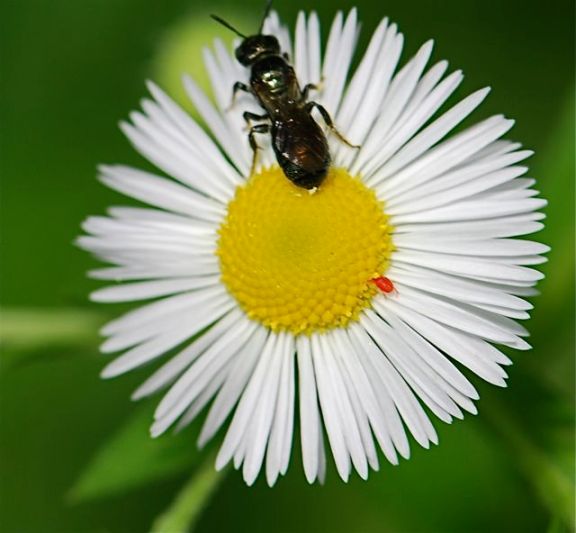What do you see in this photograph?
Do you see a dark-colored bee sitting in a flower? Look again.
Can you see the red critter across from the bee?
That is a mite, a small spider relative with eight legs.
A few weeks ago I attended a conference, and a question came up a whether these large red mites on flowers are harming the plants. Are they a type of plant-feeding mite?
At the time, I thought the red mites were the same ones I often see rapidly running around on plants and in the compost heap. Those mites eat the eggs and immatures of insects and other arthropods. They are predatory. Some are called predatory running mites, genus Anystis.
In the desert, there are velvet mites (Family Trombidiidae) that are red. Some are over a quarter inch long, which is giant for mites. Velvet mites are also predatory, mostly on insects such as termites and ants.
The mite in the photograph above, however, seems to have it’s head in one of the flowers (this type of composite “flower” is actually a group of tiny flowers clustered together.) The mite doesn’t seem to be going after the bee at all.
Curious, I decided to do some research. After poking around, it seems the mite in the photograph is likely to be a member of the genus Balaustium. These mites are predatory in the young stages, but also feed on pollen as adults. Of course, feeding on pollen doesn’t harm the plants. The bees take loads of it.
Sometimes the mites are found clustering together in the spring. No one knows for sure why.
I wonder why they are so brightly colored?
Have you ever seen red mites?





Nasty looking bug, isn’t it? Why bright red? Maybe to look poisonous?
Red is often a warning coloration…
Hello i have a lott off this mites around my jarden in marbella spain. Mayby i can sent a picture off it to look if its the same ones? It seems they like the sun and the plants i was wondering if they also bite people? Can i send you some photos of it ?
Miloo,
You probably would be better off trying to find a local expert to talk to about this. There are some 50,000 different species of mites and most are much too small to be able to identify from a photograph.